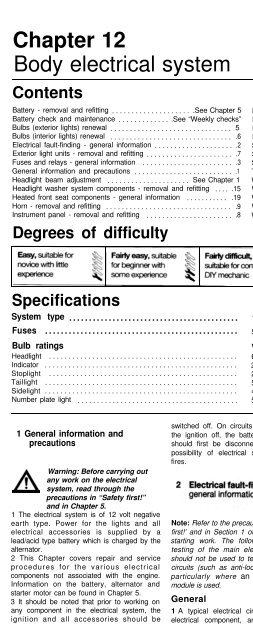Contents - Volkspage
Contents - Volkspage
Contents - Volkspage
Create successful ePaper yourself
Turn your PDF publications into a flip-book with our unique Google optimized e-Paper software.
12.1<br />
Chapter 12<br />
Body electrical system<br />
<strong>Contents</strong><br />
Battery - removal and refitting .................... .See Chapter 5 Loudspeakers - removal and refitting ........................ .17<br />
Battery check and maintenance ............. .See “Weekly checks” Radio aerial - removal and refitting ......................... .18<br />
Bulbs (exterior lights) renewal ............................... 5 Radio/cassette player - removal and refitting .................. .16<br />
Bulbs (interior lights) renewal ............................... .6 Reversing light switch .......................... .See Chapter 7<br />
Electrical fault-finding - general information .................... .2 Speedometer drive cable - removal and refitting ............... .10<br />
Exterior light units - removal and refitting ...................... .7 Stop light switch - removal and refitting ............ .See Chapter 9<br />
Fuses and relays - general information ....................... .3 Switches and cigarette lighter - removal and refitting ............ .4<br />
General information and precautions ......................... .1 Tailgate wiper motor - removal and refitting ................... .13<br />
Headlight beam adjustment ..................... See Chapter 1 Windscreen washer system check and adjustment ... .See Chapter 1<br />
Headlight washer system components - removal and refitting .... .15 Washer system components - removal and refitting ............ .14<br />
Heated front seat components - general information ........... .19 Wiper blade check and renewal ............. .See “Weekly checks”<br />
Horn - removal and refitting<br />
................................ .9 Windscreen wiper motor and linkage - removal and refitting ...... .12<br />
Instrument panel - removal and refitting ...................... .8 Wiper arm - removal and refitting ........................... .11<br />
Degrees of difficulty<br />
Specifications<br />
System type ...........................................<br />
Fuses .................................................<br />
Bulb ratings<br />
Headlight ................................................<br />
Indicator .................................................<br />
Stoplight ................................................<br />
Taillight .................................................<br />
Sidelight .................................................<br />
Number plate light .........................................<br />
12-volt negative earth<br />
See Wiring diagrams at end of Chapter<br />
Watts<br />
60/55<br />
21<br />
21<br />
5<br />
4<br />
5<br />
1 General information and<br />
precautions<br />
Warning: Before carrying out<br />
any work on the electrical<br />
system, read through the<br />
precautions in “Safety first!”<br />
and in Chapter 5.<br />
1 The electrical system is of 12 volt negative<br />
earth type. Power for the lights and all<br />
electrical accessories is supplied by a<br />
lead/acid type battery which is charged by the<br />
alternator.<br />
2 This Chapter covers repair and service<br />
procedures for the various electrical<br />
components not associated with the engine.<br />
Information on the battery, alternator and<br />
starter motor can be found in Chapter 5.<br />
3 It should be noted that prior to working on<br />
any component in the electrical system, the<br />
ignition and all accessories should be<br />
switched off. On circuits which are live with<br />
the ignition off, the battery negative terminal<br />
should first be disconnected to prevent the<br />
possibility of electrical short circuits and/or<br />
fires.<br />
Note: Refer to the precautions given in ‘Safety<br />
first!’ and in Section 1 of this Chapter before<br />
starting work. The following tests relate to<br />
testing of the main electrical circuits, and<br />
should not be used to test delicate electronic<br />
circuits (such as anti-lock braking systems),<br />
particularly where an electronic control<br />
module is used.<br />
General<br />
1 A typical electrical circuit consists of an<br />
electrical component, any switches, relays,<br />
motors, fuses, fusible links or circuit breakers<br />
related to that component, and the wiring and<br />
connectors which link the component to both<br />
the battery and the chassis. To help pinpoint a<br />
problem in an electrical circuit, wiring<br />
diagrams are included at the end of this<br />
Manual.<br />
2 Before attempting to diagnose an electrical<br />
fault, first study the appropriate wiring<br />
diagram to obtain a complete understanding<br />
of the components included in the particular<br />
circuit concerned. The possible sources of a<br />
fault can be narrowed down by noting if other<br />
components related to the circuit are<br />
operating properly. If several components or<br />
circuits fail at one time, the problem is likely to<br />
be related to a shared fuse or earth<br />
connection.<br />
3 Electrical problems usually stem from<br />
simple causes, such as loose or corroded<br />
connections, a faulty earth connection, a<br />
blown fuse, a melted fusible link, or a faulty<br />
relay (refer to Section 3 for details of testing

















